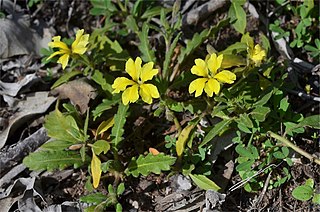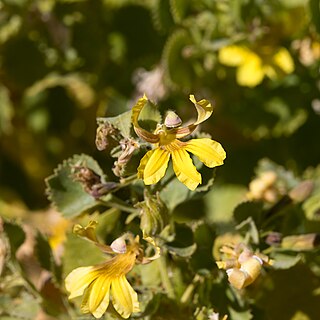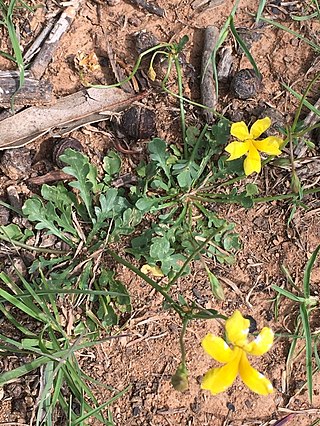
Goodenia byrnesii is a species of flowering plant in the family Goodeniaceae and is endemic to northern Australia. It is prostrate to low-lying herb with short-lived, lance-shaped leaves at the base, egg-shaped to oblong, toothed stem leaves, and leafy racemes of yellow flowers.

Goodenia cycloptera is a species of flowering plant in the family Goodeniaceae and is endemic to Australia. It is a widely distributed, perennial or annual herb with wavy or toothed leaves, yellow flowers arranged in leafy racemes and more or less spherical fruit.

Goodenia eatoniana is a species of flowering plant in the family Goodeniaceae and is endemic to the extreme south-west of Western Australia. It is a perennial herb with lance-shaped leaves at the base of the plant, egg-shaped stem leaves, and racemes of blue flowers.

Goodenia grandiflora, commonly known as large-flowered goodenia, pinnate goodenia or mountain primrose, is a species of flowering plant in the family Goodeniaceae and is endemic to Australia. It is an erect under-shrub with toothed, egg-shaped to round leaves and racemes or thyrses of yellow, white or purplish flowers.
Goodenia havilandii, commonly known as hill goodenia, is a species of flowering plant in the family Goodeniaceae and is endemic to the drier parts of southern Australia. It is a prostrate to ascending, short-lived herb with sticky leaves and racemes of yellowish flowers with a brown centre.

Goodenia heppleana is a species of flowering plant in the family Goodeniaceae and is endemic to northern Australia. It is an erect or prostrate herb with lance-shaped leaves at the base of the plant and racemes of yellow flowers.

Goodenia heterochila, commonly known as serrated goodenia, is a species of flowering plant in the family Goodeniaceae and is endemic to arid areas of Australia. It is an erect or ascending perennial herb with lance-shaped to egg-shaped stem leaves with the narrow end towards the base, and racemes of yellow flowers with a brownish centre.

Goodenia hirsuta is a species of flowering plant in the family Goodeniaceae and is endemic to northern Australia. It is a hairy, prostrate to low-lying perennial herb with narrow egg-shaped leaves at the base of the plant, racemes of hairy yellow flowers and oval to elliptic fruit.
Goodenia janamba is a species of flowering plant in the family Goodeniaceae and is endemic to northern Australia. It is an erect herb with linear to lance-shaped leaves mostly at the base of the plant, and umbels or racemes of flowers that are yellow, or purplish with a yellow centre.
Goodenia leiosperma is a species of flowering plant in the family Goodeniaceae and is endemic to the Northern Territory. It is an ascending to low-lying herb with egg-shaped to lance-shaped stem-leaves and racemes of yellow flowers.
Goodenia malvina is a species of flowering plant in the family Goodeniaceae and is endemic to north-western Australia. It is a prostrate to low-lying herb with egg-shaped to lance-shaped leaves on the stems and racemes of mauve to pinkish and yellowish flowers.
Goodenia megasepala is a species of flowering plant in the family Goodeniaceae and is endemic to Queensland. It is a prostrate to low-lying herb with toothed or lobed, lance-shaped to narrow elliptic leaves, and racemes of yellow flowers.
Goodenia muelleriana is a species of flowering plant in the family Goodeniaceae and is endemic to the north-west of Western Australia. It is an ascending to erect herb with elliptic to lance-shaped leaves at the base of the plant, and racemes of yellow flowers.
Goodenia occidentalis, commonly known as western goodenia, is a species of flowering plant in the family Goodeniaceae and is endemic to drier parts of southern Australia. It is a short-lived prostrate to low-lying herb with scaly, lance-shaped leaves and racemes of yellow flowers with a brownish centre.
Goodenia odonnellii is a species of flowering plant in the family Goodeniaceae and is endemic to northern Australia. It is an erect to low-lying herb with oblong to egg-shaped leaves with toothed or lyrate edges, and racemes of yellow flowers.

Goodenia pinnatifida, commonly known as cut-leaf goodenia, scrambled eggs or mother ducks, is a species of flowering plant in the family Goodeniaceae and endemic to Australia. It is a low-lying to ascending perennial herb with toothed to pinnatisect leaves, racemes of yellow flowers and more or less spherical fruit.

Goodenia pusilliflora, commonly known as small-flower goodenia, is a species of flowering plant in the family Goodeniaceae and is endemic to drier parts of southern Australia. It is a low-lying to ascending herb with oblong to egg-shaped leaves with toothed or lyrate edges, and racemes of small yellow flowers.
Goodenia quadrifida is a species of flowering plant in the family Goodeniaceae and is endemic to a restricted part of the Northern Territory. It is an ascending herb with glabrous foliage, narrow oblong to lance-shaped leaves at the base of the plant and racemes of purplish-brown flowers.
Goodenia redacta is a species of flowering plant in the family Goodeniaceae and is endemic to northern Australia. It is a prostrate to low-lying herb with toothed, egg-shaped leaves at the base of the plant, and racemes of yellow flowers with a brownish centre.

Goodenia triodiophila, commonly known as spinifex goodenia in the Northern Territory, is a species of flowering plant in the family Goodeniaceae and is endemic to arid inland areas of Central Australia. It is a stiff, wiry, much-branched, ascending perennial herb with needle-shaped or linear leaves on the stems and racemes of yellow flowers with a brownish centre.










